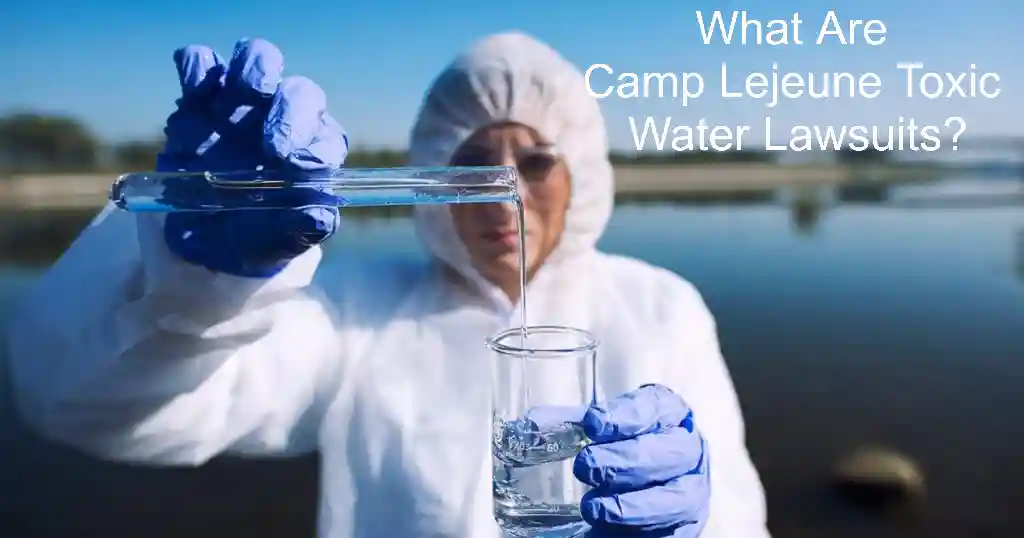The Camp Lejeune Toxic Water Lawsuits represent one of the largest military contamination cases in U.S. history. These lawsuits seek justice for thousands of veterans and their families who were exposed to toxic chemicals in contaminated drinking water at Marine Corps Base Camp Lejeune in North Carolina.

What Are Camp Lejeune Toxic Water Lawsuits?
Camp Lejeune Toxic Water Lawsuits are legal claims filed by veterans, family members, and civilian workers who were exposed to contaminated water at the military base between 1953 and 1987. The lawsuits seek compensation for serious health conditions caused by toxic chemical exposure.
Key Facts About the Contamination:
- Water contamination occurred from the early 1950s to 1987
- Over one million people were potentially exposed to toxic chemicals
- Four major toxic chemicals were identified in the water supply
- The most contaminated wells were shut down in 1985
- The contamination affected multiple areas of the base
History of Water Contamination at Camp Lejeune
The water contamination at Camp Lejeune began in the early 1950s and continued for decades. The contamination of drinking water at Camp Lejeune began in the early 1950s and the most contaminated wells were shut down in 1985.
Timeline of Key Events:
- 1950s: Water contamination begins at the base
- 1982: Marine Corps investigation reveals toxic chemicals in water
- 1984: Military starts testing wells, finding ten contaminated wells
- 1985: Most contaminated wells are shut down
- 2022: Camp Lejeune Justice Act is signed into law
- August 2024: Deadline for filing administrative claims

Toxic Chemicals Found in Camp Lejeune Water
The government identified four major toxic chemicals in the Camp Lejeune water supply. These chemicals are known to cause serious health problems and cancer.
Primary Contaminants:
Trichloroethylene (TCE)
- Used as an industrial solvent
- Found at extremely high levels in the water
- May 1982 testing found TCE levels at 1,400 ppb, while the current standard for TCE is 5 ppb.
- Known to cause cancer and other serious health conditions
Perchloroethylene (PCE)
- Also known as tetrachloroethylene or “Perc”
- Commonly used in dry cleaning operations
- PCE is typically degraded by natural processes in the soil and groundwater to TCE, trans-1,2-dichloroethylene (1,2-DCE), and vinyl chloride.
- Linked to various cancers and health problems
Benzene
- In July 1984, a different company contracted under the EPA’s Superfund review of Lejeune and other sites found benzene in the base’s water, along with PCE and TCE.
- Known carcinogen
- Found in multiple wells across the base
- Causes blood cancers and other serious conditions
Vinyl Chloride
- Formed when PCE breaks down naturally
- Highly toxic chemical
- Known to cause liver cancer and other health problems
- Found in groundwater at dangerous levels
Health Conditions Linked to Camp Lejeune Water Contamination
Exposure to toxic chemicals in Camp Lejeune water has been linked to numerous serious health conditions. These conditions affect veterans, their families, and civilian workers who lived or worked at the base.
Cancers Associated with Exposure:
- Bladder cancer
- Breast cancer
- Cervical cancer
- Esophageal cancer
- Female infertility
- Hepatic steatosis (fatty liver disease)
- Kidney cancer
- Leukemia
- Liver cancer
- Lung cancer
- Miscarriage
- Multiple myeloma
- Myelodysplastic syndromes
- Neurobehavioral effects
- Non-Hodgkin’s lymphoma
- Renal toxicity
- Scleroderma
Other Health Problems:
- Birth defects in children
- Neurological disorders
- Immune system problems
- Reproductive issues
- Developmental delays in children
- Cardiac defects
Camp Lejeune Justice Act: Legal Foundation for Lawsuits
The Camp Lejeune Justice Act was signed into law in August 2022 as part of the PACT Act. This law allows victims of Camp Lejeune water contamination to file lawsuits against the federal government for damages.
Key Provisions of the Act:
- Allows lawsuits against the U.S. government for Camp Lejeune water contamination
- Covers veterans, family members, and civilian workers
- Requires exposure for at least 30 days between 1953-1987
- Bypasses North Carolina’s statute of repose
- Provides a two-year window to file claims
Who Can File Camp Lejeune Toxic Water Lawsuits:
- Veterans who served at Camp Lejeune
- Family members who lived on base
- Civilian employees who worked at the base
- Anyone exposed to contaminated water for 30+ days
- Surviving family members of deceased victims
Current Status of Camp Lejeune Toxic Water Lawsuits in 2025
The Camp Lejeune Toxic Water Lawsuits are progressing through the legal system with significant developments in 2025.
Recent Developments:
- The deadline to file a Camp Lejeune claim is August 10, 2024.
- Over 232,000 claims have been filed with the Navy
- Bellwether trials are being prepared for the first half of 2024
- Settlement negotiations are ongoing
- Special Masters appointed to oversee Camp Lejeune water contamination settlement discussions indicate that a global agreement to resolve claims could be reached by the end of 2025.
Settlement Expectations:
- For example, if 110,000 claims are accepted, that would be an average per-person Camp Lejeune settlement amount of $200,000.
- Settlement amounts will vary based on:
- Type and severity of health condition
- Duration of exposure
- Medical expenses incurred
- Pain and suffering
- Lost wages and earning capacity
How to File Camp Lejeune Toxic Water Lawsuits
Filing a Camp Lejeune toxic water lawsuit involves several important steps. While the administrative claim deadline has passed, legal options may still be available.
Steps for Filing:
- Gather military service records
- Collect medical documentation
- Document time spent at Camp Lejeune
- Prove connection between exposure and illness
- File administrative claim with the Navy
- Work with an experienced attorney
Required Documentation:
- Military orders showing assignment to Camp Lejeune
- Medical records showing diagnosed conditions
- Proof of residence or work at the base
- Death certificates (for wrongful death claims)
- Medical bills and treatment records
- Employment records for civilian workers
Compensation Available in Camp Lejeune Toxic Water Lawsuits
Victims of Camp Lejeune water contamination may be entitled to significant compensation for their injuries and losses.
Types of Damages Available:
- Medical expenses (past and future)
- Pain and suffering
- Lost wages and earning capacity
- Disability benefits
- Wrongful death damages
- Funeral and burial expenses
- Loss of consortium
- Punitive damages (in some cases)
Factors Affecting Settlement Amounts:
- Severity of the health condition
- Age at time of exposure
- Duration of exposure to contaminated water
- Medical costs and ongoing treatment needs
- Impact on quality of life
- Lost income and earning potential
- Strength of the medical evidence
Areas of Camp Lejeune Affected by Water Contamination
The toxic water contamination affected multiple areas of Camp Lejeune, exposing different groups of people to dangerous chemicals.
Primary Contaminated Areas:
Hadnot Point Water System
- Supplied water to Mainside barracks
- Served Hospital Point family housing
- Provided water to Midway Park
- Served Paradise Point housing
- Supplied Berkeley Manor until 1972
- All wells at Hadnot Point had traces of benzene.
Tarawa Terrace Water System
- Served family housing areas
- identified as present at Tarawa Terrace is PCE.
- Contaminated with perchloroethylene
- Affected hundreds of military families
Buildings and Facilities Affected:
- Base housing units
- Barracks and dormitories
- Hospital facilities
- Mess halls and dining facilities
- Administrative buildings
- Recreation centers
- Child development centers
- Base schools
Legal Process for Camp Lejeune Toxic Water Lawsuits
Understanding the legal process helps claimants know what to expect when pursuing Camp Lejeune Toxic Water Lawsuits.
Administrative Claims Process:
- Claims must first be filed with the Navy
- Six-month review period for the government
- Denial or no response allows federal lawsuit
- Administrative process required before court filing
Federal Court Litigation:
- Cases filed in Eastern District of North Carolina
- Multidistrict litigation (MDL) established
- Bellwether trials to test case strength
- Settlement negotiations ongoing
- A March 25, 2025, Phase I hearing will be critical in the Camp Lejeune lawsuit, and the resulting updates will hopefully help
Trial Locations:
- Raleigh, North Carolina
- New Bern, North Carolina
- Elizabeth City, North Carolina
- Wilmington, North Carolina
Challenges in Camp Lejeune Toxic Water Lawsuits
Several challenges face victims pursuing Camp Lejeune Toxic Water Lawsuits, but legal remedies are available.
Common Challenges:
- Proving exposure to contaminated water
- Linking health conditions to chemical exposure
- Gathering decades-old medical records
- Establishing timeline of residence or service
- Dealing with government bureaucracy
- Complex medical causation issues
Overcoming Legal Obstacles:
- Work with experienced Camp Lejeune attorneys
- Utilize military service records
- Obtain expert medical testimony
- Use epidemiological studies
- Leverage government investigations
- Document exposure through base assignments
Differences Between VA Benefits and Camp Lejeune Toxic Water Lawsuits
Veterans may be eligible for both VA benefits and compensation through Camp Lejeune Toxic Water Lawsuits.
VA Benefits:
- Healthcare for specific presumptive conditions
- Disability compensation
- Family healthcare benefits
- No lawsuit required
- Administrative process
- Ongoing medical care
Camp Lejeune Toxic Water Lawsuits:
- Monetary compensation for damages
- Pain and suffering awards
- Full medical expense reimbursement
- Lost wages compensation
- Court-supervised process
- One-time settlement payment
Important Considerations:
- VA benefits don’t preclude lawsuits
- Different eligibility requirements
- Separate application processes
- Both can provide valuable compensation
- Legal representation recommended for lawsuits
Scientific Evidence Supporting Camp Lejeune Toxic Water Lawsuits
Strong scientific evidence supports the connection between Camp Lejeune water contamination and serious health problems.
Government Studies:
- Agency for Toxic Substances and Disease Registry (ATSDR) studies
- National Academy of Sciences reviews
- CDC health investigations
- Environmental Protection Agency assessments
- Military health surveillance reports
Key Research Findings:
- Increased cancer rates among exposed individuals
- Birth defects in children of exposed parents
- Higher rates of neurological disorders
- Elevated levels of liver disease
- Increased miscarriage rates
- Developmental delays in children
Expert Medical Testimony:
- Toxicologists confirm chemical dangers
- Epidemiologists show disease patterns
- Oncologists link cancers to exposure
- Pediatricians document birth defects
- Neurologists identify brain disorders
Statute of Limitations for Camp Lejeune Toxic Water Lawsuits
The Camp Lejeune Justice Act provides specific time limits for filing lawsuits.
Important Deadlines:
- The deadline to file a Camp Lejeune claim is August 10, 2024.
- Two-year window from law’s enactment
- Administrative claims required first
- Federal lawsuits after claim denial
- No extensions expected for missed deadlines
Protecting Your Rights:
- Act quickly if you believe you qualify
- Consult with attorneys immediately
- Gather documentation promptly
- File administrative claims on time
- Don’t miss critical deadlines
- Seek legal help for complex cases
Choosing Legal Representation for Camp Lejeune Toxic Water Lawsuits
Selecting the right attorney is crucial for successful Camp Lejeune Toxic Water Lawsuits.
Qualities to Look For:
- Experience with mass tort litigation
- Knowledge of military law and procedures
- Track record with toxic exposure cases
- Resources to handle complex litigation
- Understanding of medical causation issues
- Compassion for veteran and family clients
Questions to Ask Potential Attorneys:
- How many Camp Lejeune cases have you handled?
- What is your success rate with similar cases?
- Do you have the resources for expert witnesses?
- How do you communicate with clients?
- What are your fee arrangements?
- Can you provide client references?
Legal Fee Arrangements:
- Most attorneys work on contingency fees
- No upfront costs for clients
- Attorney fees paid from settlement
- Typical contingency rates: 33-40%
- Costs advanced by law firm
- Free initial consultations available
Future Outlook for Camp Lejeune Toxic Water Lawsuits
The future of Camp Lejeune Toxic Water Lawsuits looks promising for victims seeking justice and compensation.
Expected Developments:
- Global settlement negotiations continuing
- Bellwether trials to establish case values
- Streamlined claims processing
- Faster resolution of cases
- Improved compensation offers
Settlement Timeline:
- Special Masters appointed to oversee Camp Lejeune water contamination settlement discussions indicate that a global agreement to resolve claims could be reached by the end of 2025.
- Individual case resolutions expected throughout 2025
- Priority given to most serious cases
- Expedited process for terminal illnesses
- Systematic resolution of all valid claims
Resources for Camp Lejeune Toxic Water Lawsuits Victims
Multiple resources are available to help victims of Camp Lejeune water contamination.
Government Resources:
- Department of Veterans Affairs
- Camp Lejeune Family Member Program
- ATSDR health assessments
- CDC health information
- Navy Judge Advocate General’s office
Legal Resources:
- Experienced mass tort attorneys
- Legal aid organizations
- Bar association referrals
- Online legal directories
- Veteran service organizations
Medical Resources:
- VA medical centers
- Specialized cancer treatment centers
- Environmental health clinics
- Registry and health surveillance programs
- Support groups for affected families
Conclusion
Camp Lejeune Toxic Water Lawsuits help sick veterans and families get money. The poison water caused cancer and death for 34 years. Over 232,000 people have filed claims. Settlement talks are happening now. Many victims will get $150,000 to $1,000,000. The government admits the water was deadly. Scientists prove it caused disease. Don’t wait – contact an experienced lawyer today. You deserve compensation for your suffering.






